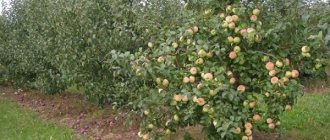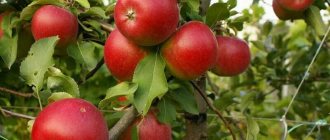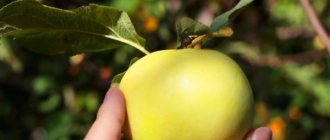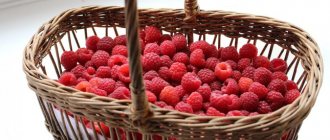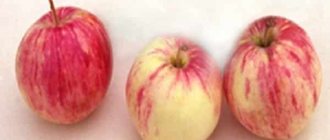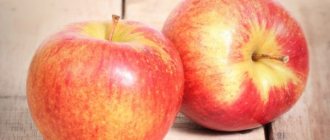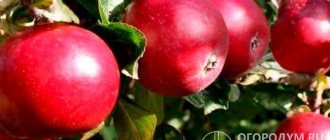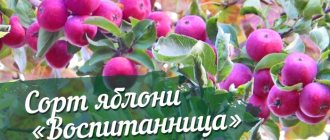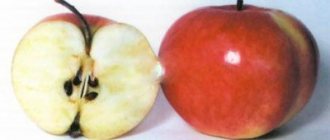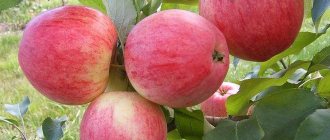Description of the Pepin Saffron apple tree
Apple trees of this variety grow to their average size in about 6 years and have a fairly dense crown in the shape of a ball with drooping branches and foliage. Young long stems with buds and foliage usually hang down to the soil. The fruits grow on thin annual branches, the length of which reaches 15 cm. The foliage of the plant is small, slightly oblong, matte and has pointed ends.
Apples of the Pepin Saffron variety grow to medium size. The fruits weigh approximately 130 g, but the average weight, as a rule, does not exceed 80-90 g. They have a slightly flattened and slightly ribbed shape.
Apples Pepin Saffron (photo):
Apples of this variety have a greenish-yellow color, on which red stripes and dots appear. During storage, when the fruits finally ripen, they acquire a more orange color. Their stalks usually reach about 3 cm in length and 2 mm in thickness. They emerge from a recess with slightly orange edges. The apples are attached to the branches very securely.
The fruit pulp is juicy, crispy and firm. It has a cream color.
Harvest and storage
The fruits of the Pepin saffron variety are characterized by the possibility of long-term storage, up to April, all this time maintaining their commercial qualities. Moreover, the taste of apples only improves over time, so do not rush to eat them immediately after picking.
To place them in storage (a standard cellar is suitable), the picked fruits are placed in wooden boxes (no more than 2 layers) and left on racks. If necessary, it is also possible to transport the fruits, which they tolerate well.
The Pepin saffron apple tree is an excellent solution for planting in the southern regions and in the middle zone, but gardeners in the northern regions will have to solve the problem of winter shelter for the tree. True, even with this inconvenience, the probability of obtaining tasty and abundant fruits is very high, so all the work will be fully compensated.
Characteristics and description of the Winter saffron apple tree
Saffron apples have good taste; with proper tree care, the yield is usually very high, about 50 kg per tree. At the same time, the fruits do not fall off and ripen on the branches.
The speed of apple ripening depends on the selected variety of Saffron apple tree. For example, the Pepin Saffron apple tree produces up to 80 kg of apples on trees that are not yet 10 years old, and up to 180 kg on older trees. And the harvest in such gardens is harvested at the end of September.
Apple Saffron
The trees reach a height of about 2.8–3 meters, the crown is usually spherical.
Trees tolerate low winter temperatures well, but require more careful feeding in places where winters are extremely cold.
Characteristics of the variety
The Saffron Pepin apple tree is a late-ripening variety that feels comfortable in almost all regions of the Russian Federation, as well as abroad.
Advantages and disadvantages
Certainly unprecedented popularity can mean a number of tangible advantages of the apple tree. Among them:
- a large amount of harvest;
- early onset of fruiting;
- resistance to pests;
- taste and quality of fruits.
Disadvantages include the lack of immunity to scab and uneven ripening of the crop.
Morphology
The Pepin apple tree is medium-sized and reaches 3 meters in height. The crown is spherical, consists of many thin drooping branches. The leaves are gray-green, pubescent, wrinkled.
Apple tree Pepin Saffron.
Flowering is abundant, snow-white, and occurs in June. Fruiting is abundant, the fruits are small, located on thin fruit twigs. They are round, green with a red blush. The sweet and sour taste is complemented by a very unusual spicy aroma. The photo below shows apples in storage.
Pollinator varieties
Although Pepin Saffron is a self-fertile variety, properly selected neighbors can positively affect the amount of harvest. Good pollinators would be:
Those varieties that bloom at the same time as Saffron are also suitable.
Winter hardiness and disease resistance
The Pepin apple tree has a high level of winter hardiness. In addition to the ability to tolerate low temperatures and severe frosts, it has good adaptive properties. This means that drastic changes such as sudden spring frosts will not damage it.
But the variety does not have immunity to scab and other fungal diseases. Therefore, you will have to regularly carry out the necessary preventive spraying to protect the apple tree. You should systematically inspect the shoots for damage, because if you miss the appearance of the first signs, you can lose the harvest.
History of variety selection
The Pepin Saffron apple variety was created in the Tambov province (now the Ryazan region) in 1907. Russian biology and selection specialist Ivan Vladimirovich Michurin contributed to this. Pepin Saffron has the best qualities, which were given to him by a couple of varieties such as Renet Orléans and a hybrid descended from the Chinese apple tree and Pepin Lithuanian. The scientist collected the first fruits from the hybrid plant in 1915.
How to quickly get rid of fleas in a private house and apartment at home: insecticides and folk remedies
Pruning and crown formation
The Pepin apple variety needs to be pruned in spring and autumn. Autumn pruning is needed to remove weak branches, which are especially susceptible to fungal infections and diseases in the cold season.
Pepin apple tree is pruned in spring and autumn
In the spring, the crown is formed using pruning. They do this from the third year of the tree’s life. To do this, trim:
- old branches on which buds and fruits no longer form;
- shoots damaged after wintering by heavy snowfalls and icing;
- branches that grow into the middle of the crown and greatly shade the young fruits;
- the top of a tree older than 8 years is removed;
Important! Pruning should not be too strong. About a quarter of the entire crown is cut off as much as possible. Otherwise, the apple tree will die. All cuts on the tree are treated with garden pitch, turpentine or pork fat.
Planting and care
Proper planting is necessary for the seedling to gain vitality and nutrients. Compliance with all principles of care will help maintain the apple tree in a healthy condition and in full fruiting.
Planting the Pepin Saffron apple tree in the fall.
Dates and methods of planting
Seedlings of Pepin Saffron, like any other, are planted in two periods: autumn or spring:
- Autumn planting takes place in September after the leaves and fruits have been harvested. However, you should plan the timing so that at least 3 weeks remain before the first frost. During this period, the seedling should have time to take root.
- In spring, planting is carried out in April, after the ground has warmed up sufficiently, but before the sap begins to move along the shoots.
The exact time and timing of planting must be determined depending on the climatic conditions of the area.
Planting a young seedling is carried out according to the standard scheme:
- it is necessary to prepare the landing pit in advance;
- mix nutrients with the top layer of soil;
- place the seedling in the center;
- Sprinkle the roots with soil, compact the soil a little and water.
It is important to take into account one point: the apple tree does not like moving. Therefore, you immediately need to find a place where it will be permanently located.
Technology
The technology for planting Pepin seedlings is standard. But there is one feature that is worth recalling. In cold climates, the apple tree is grown in a slate form to make it easier to cultivate and insulate.
Seedlings Pepin Saffron.
With this form, planting has one feature: the seedling is located at an angle of 45 degrees. Skeletal shoots will need to be bent to the ground.
Agricultural technology
Correct agricultural techniques are not complicated and are easy to implement. Among them:
- regular watering. The apple tree loves regular watering; it needs to be watered twice a month. For an adult tree, the norm is one and a half to two buckets of water;
- application of fertilizers. Fertilizing must be done to improve the immunity of the apple tree. In the spring, nitrogen-containing fertilizers are applied, at the beginning of budding, phosphorus-potassium and ash are applied, in the summer mineral fertilizers are applied to the leaves, and in the fall it is necessary to apply organic matter under the ground so that the apple tree is prepared for the cold season. In the first year after planting, no fertilizing is applied;
- loosening of the tree trunk circle is carried out after each watering, and weed removal - if necessary.
All these events are held every year.
Autumn care
In addition to fertilization, several more activities will need to be carried out in the fall. It is important to carefully examine the condition of the fruit crop, especially the trunk. Any damage will need to be cleaned and treated with garden varnish. This is important to prevent infection by viruses.
Whitewashing is also necessary, although some gardeners and gardeners may ignore this procedure. Whitewashing will help protect a young apple tree from the effects of rodents, frost and sunburn.
Pruning and crown formation
The fast growth and large number of small shoots of the Pepin Saffron variety encourage regular pruning. The procedure is carried out twice per season: in autumn and spring.
Proper pruning of the crown of an apple tree.
At the beginning of the season, young shoots that grow fat and those that grow inward are cut off. For the most part, spring pruning serves to form the crown correctly. In the fall, remove damaged or weakened branches.
You need to be careful not to cut off a large number of shoots from the tree. If the crown is removed by more than a quarter, the apple tree may suffer. The video details the technology of the procedure.
Productivity and keeping quality of fruits
Saffron apples have amazing yields. The fruits are medium-sized and even small, but 250 kg, and sometimes 280 kg, can be collected from a tree. They have a pleasant apple taste, a fresh aroma, a slightly wine note with subtle sourness will add a pleasant piquancy.
The winter-ripening variety is notable for its shelf life for a very long time. Fruits can remain for 7-8 months without loss of taste and appearance. Apples are picked from the tree in September, but they are not yet endowed with all the taste characteristics. They will acquire real taste in a month and a half.
Landing Features
Recommended timing
It is recommended to plant seedlings in autumn or spring. The plant takes root best in the spring, which helps it better survive the winter. In autumn, you need to prepare seedlings for frost. The main thing is to plant the seedlings in pre-prepared soil.
Choosing a suitable location
When choosing a place for planting, you should pay attention to the following points: you need to immediately choose a permanent place, since this variety does not tolerate transplantation, and you also need to select solid soil with good lighting. Lack of light can make the fruits small and unsweetened.
Floodplain soils, leached chernozem and loams are suitable for Pepin Saffron.
Selection and preparation of planting material
If you plant a plant in the autumn, you need to prepare the soil in advance in August. To fertilize the site, you need to mix potassium salt (40 g), superphosphate (50 g) and manure or compost (5 kg) and distribute evenly over the entire site. After this, the soil must be dug up to mix it with fertilizer.
Before spring planting, the soil should be prepared in the fall. To do this, it is necessary to dig a planting pit, the depth of which should be about 1 m, and the diameter - 1.5 m. The soil in it must be dug up with a mixture of compost (7 kg), ash (450 g) and azofoska (250 g). The fertilized pit should be closed until spring arrives.
Before planting, it is necessary to moisten the roots of the seedling in any insecticide solution to protect the plant from pests.
Landing algorithm
During the planting process, it is very important not to bury the seedling too deep into the soil. Its neck should be at a height of 6-7 cm from the ground. The algorithm for planting the Pepin Saffron apple tree is as follows:
- Dig a hole, the depth of which is approximately 0.7-0.8 m and the width is 1 m.
- Make a small slide at the bottom.
- Place the seedling in the hole and bury it.
- Compact the soil with your feet.
- Drive two pegs along the edges of the hole and tie a seedling to them.
- Fill the soil with a bucket of water.
Disembarkation
For apple trees of this variety, special conditions for planting are created. Fastidious but productive, such a crop requires multi-stage preparation of the planting pit. The depth of such a hole is 60-70 cm, and the diameter is more than 70 cm. The hole is immediately fertilized.
To do this, use compost or slurry. Any organic matter to enrich the planting pit is laid in a thick layer. In total, you need at least 5 cm of such fertilizer. After this, the pit is covered with film.
The Pepin Saffron variety is planted using two-year-old material. It is better not to take a one-year-old, because its survival rate is lower. The seedling is pre-soaked. You can use regular warm water or Fitosporin solution. The purchased product helps strengthen the seedling’s immunity.
By the time of planting, the pit should have settled for at least 2 weeks. After this, it is dug up and drainage is placed at the bottom. An additional system will help remove excess moisture from the rhizome so that it does not rot.
After this, a seedling with a cleaned root system is placed in the hole. Fresh soil is poured on top. A roller is made around the trunk - this is a prerequisite for proper watering in the coming year. The tree is moistened abundantly.
Features of autumn planting
The ground under the trees needs to be loosened regularly
An apple tree is planted twice a year. The autumn procedure is the simplest, but riskiest. The planting date is calculated based on harvesting. First, all the fruits are removed from the trees. After this, the land area is cleared of leaves and weeds.
The main difference between spring and autumn plantings is the timing of pit preparation. In the fall, this is done 2-3 weeks before planting. From the moment the seedling is placed in the ground, at least a month must pass before the onset of frost. Only in such conditions will the tree take root faster.
To properly carry out autumn planting, you must:
- dig the hole twice - after one and two weeks, and in the third week planting is carried out;
- First, the land area around the hole is well dug up so that no soil lumps or plant roots remain;
- immediately after planting, water the tree - after another month, regular care is completely stopped until spring;
- at the end, cover the seedling so that its root system is not damaged.
To protect the apple tree, mulch is used - hay, grass and peat are mixed. They don't clean it all winter. When snow falls, it serves as a second protective layer for the crop.
Features of spring planting
Spring or summer planting is the best option for this species. May or June is suitable for these purposes. The exact date varies by region. The warmer it is, the faster the landing is carried out. This procedure has two main conditions:
- warming up the soil. If the soil layer does not warm up, the tree will die immediately. To prevent this from happening, the gardener measures the layer of heated soil. The minimum value is 10-13 cm. Planting in the spring should not be allowed until the last frost, otherwise the seedling will disappear. It is better to plan work on open ground by the end of May;
- restoration of fruit trees in the garden. Warming up the soil is an important component of seedling adaptation, but the flowering period is no less important. If you do not have time to plant an apple tree before the ovaries appear on mature trees, the planting material will grow in less favorable conditions.
The advantage of spring planting is that the planted material has time to germinate before autumn. It has a strong root system that is not afraid of the first frosts. Seedlings of the variety are purchased in the fall, then they can be preserved until spring: for this, the “digging” procedure is carried out.
Care and pruning
Caring for these trees is not difficult, but in order to fully benefit from the harvest, you need to know about the correct techniques for watering and planting trees.
The soil
Saffron (crocus)
When planting such varieties in your garden, you should focus on the following parameters that the soil must meet:
- soil type - loam or sandstone;
- acidity not higher than 6.5 pH.
Before planting, it is worth enriching the soil with peat (1 part), rotted manure (2 parts) and sand (1/2), and also, if necessary, add ash.
Important! If the area has high groundwater, part of the sand must be increased by half, seedlings should be planted in high places to prevent the development of black rot in the roots.
Watering
Watering the apple tree
Young trees need watering, although if the region has hot summers, it is worth watering mature apple trees so that the harvest ripens on time.
It is worth watering the seedlings with settled water, because the temperature of the water from the well or borehole is too low and this can negatively affect the root system.
Fertilizer
After the snow melts, it is necessary to apply up to 2 buckets of rotted manure under each apple tree. Mineral fertilizers are best applied at the end of April, before flowering begins. If potassium is added by spraying, this must be done before flowering begins.
Trimming
Sanitary pruning, clearing the tree of old and diseased branches, is carried out in early October after harvesting; it is advisable to wait until the leaves fall, then all the affected areas will be visible.
In spring, pruning is carried out to form the crown. To do this, you need to cut off all the branches growing towards the ground, then the overgrown side branches, and then shorten the upper branches.
Important! If autumn pruning has not been carried out, this must be done in the spring.
Apple tree pruning
Features of fruiting
The tree is medium-sized, usually reaching a height of no more than 3 m. The crown is dense, at the age of fruiting it acquires a wide-round shape and a weeping appearance, as long and thin branches become drooping. The bark on the shoots is greenish and, due to its strong pubescence, appears covered with a gray coating. The leaves are also pubescent and grayish, matte, small, oval with an elongated sharp tip.
The main agrotechnical recommendation for caring for an apple tree is regular thinning pruning of the crown. When it thickens, the fruits become very small and tend to fall off and become scabby.
The variety is early-fruiting - the tree enters productive age in the 5-7th year after planting (according to some sources, in the 3rd-4th year). Fruiting is concentrated mainly on growth shoots: spears and fruit twigs.
Pollination specifics and productivity indicators
In terms of flowering time, “Pepin saffron” belongs to the group of late-flowering plants and, unlike most representatives of the crop, has a high degree of self-fertility . Its flowers can be pollinated by their own pollen even in bad weather and in the absence of insects, which ensures a bountiful harvest every year, without the “rotation effect”. The variety is considered one of the best pollinating partners for other apple trees, for example, “Zhigulevskoye”, “Sinap Orlovsky”, “Antonovka”. Joint planting also helps to increase the yield of Pepin saffron.
According to the results of field tests at the Voronezh experimental station (from 1948 to 1955), the average yield was 48 kg per tree or 75 c/ha, while a sharp periodicity of fruiting was observed. The maximum yield from one apple tree was recorded at 305 kg.
Qualitative characteristics of fruits
The apples are quite small, in young plants they are larger - medium in size, weighing 65-85 g (maximum up to 130 g), with a long thin stalk. They have a regular symmetrical round-conical or oblong-ovoid shape with very weak ribbing. The skin is smooth and durable, at the stage of technical ripeness it is colored greenish-yellow, which becomes golden or orange-yellow as it ripens. Almost the entire surface is filled with a bright red blurred blush with darker stripes and strokes. Subcutaneous dots are white, small, numerous. The funnel is narrow and deep, with slightly rusty walls. Calyx closed; the saucer is small, with slight tuberosity. Seed chambers are closed.
The pulp is yellowish-cream, dense, juicy, with a subtle spicy aroma. The taste is sweet and sour, wine-like, rated by tasters at 4.0-4.5 points (out of 5). ratio (SAR) is around 19 , that is, almost optimal. According to VNIISPK research, the biochemical composition of fruits contains:
The fruits are suitable for all types of processing and are a valuable raw material for making jam and producing juices, as they are characterized by a high content of P-active substances (flavonoids and phenols).
The harvest is usually harvested in September, and apples reach consumer ripeness after 2-3 months, when their taste and aroma are fully revealed. The indicators of transportability and keeping quality are high; with properly organized storage, the fruits do not lose their marketable and consumer qualities until spring (223 days).
Origins and zoning
The variety was created at the beginning of the 20th century (1907-1915) by the outstanding domestic breeder Ivan Vladimirovich Michurin and is rightfully included in his “golden heritage”. Bred by crossing "Renet d'Orléans" with a hybrid seedling obtained from "Pepin Lithuanian" and "Kitaika".
State variety trials of “Pepina saffron” have been carried out since 1939; in 1947 it was officially included in the State Register of Breeding Achievements and allowed for cultivation in almost all regions, with the exception of the Northern, Ural and Far Eastern regions due to its insufficient winter hardiness. In Siberia, the variety is recommended for cultivation in a creeping (slate) form.
How and where to store apples in winter?
With proper care, saffron pepin begins to bear fruit in the 5th-6th year of cultivation. Every year, giving a bountiful harvest. Trees under 10 years old produce 80 kg of apples, and trees older than 10 years – up to 200 kg. The harvest is harvested in late September - early October, consumer maturity occurs after 2 months of storage.
Storing fruits requires compliance with the following rules:
- Harvesting must be done carefully, avoiding damage to the fruit;
- Apples are best preserved in wooden or plastic containers;
- To separate them, use paper, shavings or tracing paper soaked in wax;
- The room temperature should be from 0 to +2;
- Only whole apples without chips, cracks or stains can be stored.
Ripening and fruiting of the Saffron apple tree
Beginning of fruiting
The first few apples may appear on the branches already in 2-3 years, but the apple tree begins to fully bear fruit only in 3-4 years.
Flowering time
The flowering period is influenced by the characteristics of the rootstock, climatic and weather conditions. However, most often the flowering coincides with most winter apple trees. It begins somewhere in mid-May and lasts no more than 10-12 days.
Fruiting and growth
You will have to wait at least eight years for full fruiting. Only then will the yields reach their maximum and it will be possible to collect more than 130 kilograms of fruits, which are densely placed on the branches. Because of this, they require supports until the apples are fully ripened. The annual growth of trees is quite high, up to 15-25 centimeters, but only in the first years.
The fruits ripen in the middle or end of September, but consumer maturity occurs only after 50-60 days. You can leave the fruits on the branches; by mid-October the lights will acquire the desired taste and aroma, but their shelf life will decrease from 200 days to 1.5-2 months.
Top dressing
- Manure.
- Bird droppings.
- Mineral complexes.
- Superphosphate.
- Compost.
What to do if it doesn’t bloom or bear fruit
- Add fertilizer.
- Water on time.
- Check for pests or diseases.
- Trim correctly.
Why do apples fall
- There is not enough moisture.
- Natural phenomena (wind, rain, hail).
- Overripe.
- Pests or diseases.
Leave a review about the Saffron apple tree in the comments below the article, so you can share your experience with other gardeners.
Previous
Apple tree varieties
